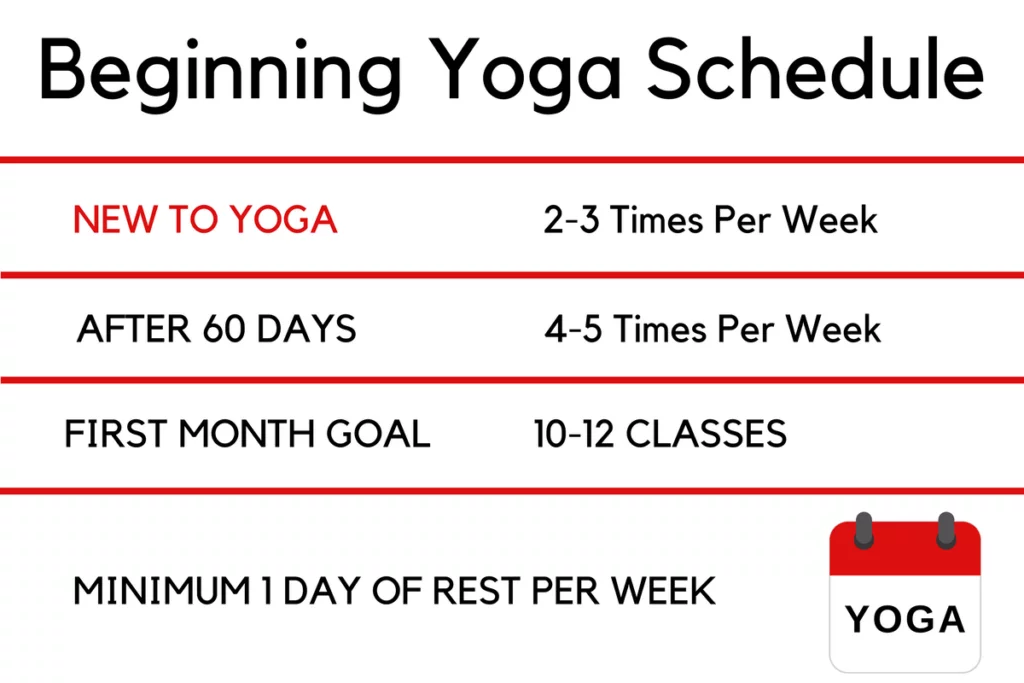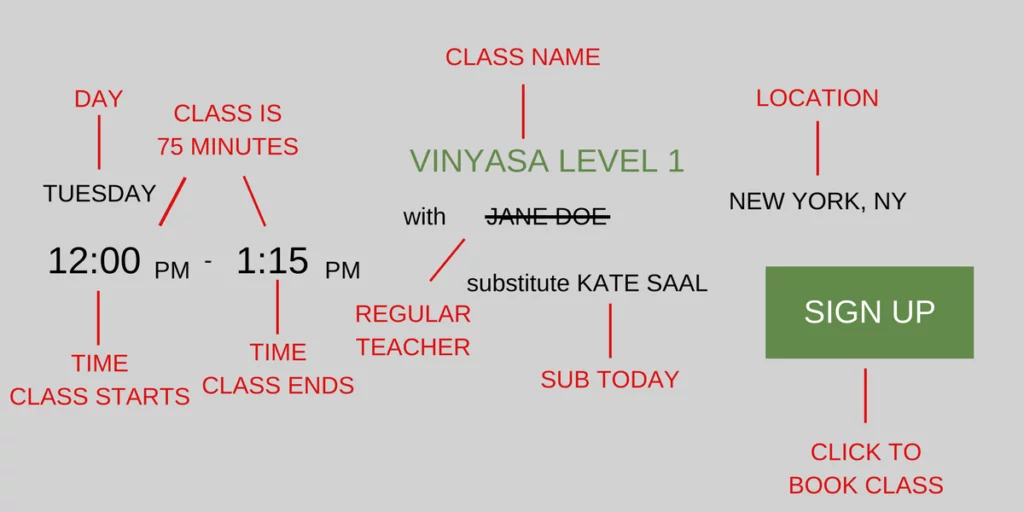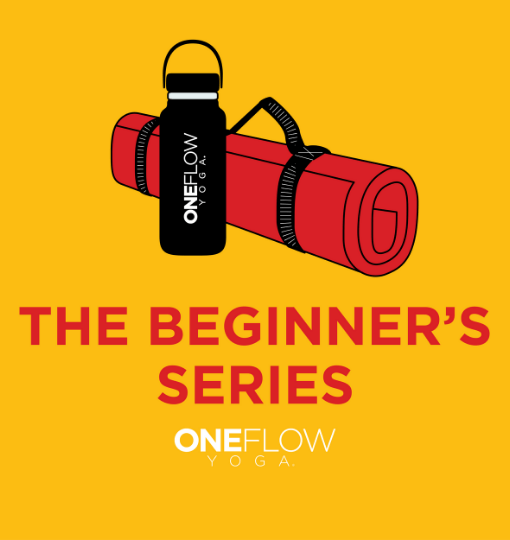You’ve made the decision that now is the time to start yoga.
That’s amazing because the benefits of yoga are many. Yoga can help you do everything from ease your back pain to get into incredible shape. Plus, it’s low impact.
Now for a few details such as how to choose a yoga class and what schedule is best when you are a beginner?
Beginning Yoga Schedule
Like any physical activity, it’s better to ease into yoga. This allows your body time to get used to the movement and build strength, balance, and flexibility. Taking it slowly also gives you an opportunity to learn specific “skills” yoga builds—such as moving with grace and fluidity.
And this approach means you’re less likely to get injured.
If you are new to yoga, aim for 2-3 times a week, with a day of rest after each practice.
But wait, I’ve heard yoga should be done daily?
That’s true, but that statement refers to yoga as a meditation practice. Yoga in a yoga studio is primarily a physical endeavor, and so your best advice is to go slow.
After 60 days you can move to 4-5 times a week. That might look like Monday, Wednesday, Friday and a Saturday or Sunday. Always have at least one day of rest each week. Your body needs time to recover, and you’ll discover you feel more energized and stronger after a day off.

Find a balance between not practicing enough (less than one time a week on average) and overdoing it. Being sore the next day indicates you overworked.
These recommendations assume that you are in good health and physically able to participate in fitness activities. Always consult your doctor if you have any concerns.
There will be differences from person-to-person, but these are reliable general guidelines. You can read about other factors to determine how often should you practice yoga here.
One common misconception is that if you work out regularly, say by running, or spinning, then you can jump right into a more rigorous schedule.
Two reasons that might not be the best approach.
First, yoga is a skill. Like any skill, it takes time to learn and develop. And while your other activities, such as CrossFit or surfing, will help you in many ways, yoga is specific to yoga.
What’s interesting is that if you change yoga practices, from Bikram yoga to vinyasa yoga, for example, your body will need a period to adjust.
The second reason is that the body gets strong based on how you use it. If you do an activity that relies on your legs, as runners or cyclists do, then that’s where you have strength. Many athletic pursuits create imbalances in our physiques because of the nature of the sport. It’s so specific that at the extreme are tennis players who have one forearm more developed than the other.
Yoga is a full body exercise. The exciting thing is over time it can help you bring balance back to your body.
Set yourself up for success by choosing a schedule that will let you practice for a long time if you so desire.
How to Stick to A Yoga Schedule
We all have good intentions, but life gets busy. Here are some strategies that can make it easier to get to your mat.
- Set a Goal
Goals give you something to focus on and make your wants more tangible. As a beginner, set a 1-month goal to complete 10-12 classes. This is specific, measurable, achievable, realistic and timely. And it will help you build momentum.
- Invite a friend
This works. Making a yoga date with others makes it more social and supportive. But don’t worry if you can’t think of anyone who might want to go, you can join a yoga studio. One of the reasons why yoga studios are popular is that they are communities. You’ll find the same people practice at the same time on the same day. And as you discover your routine you’ll meet others who will become friends.
- Schedule it
Put the times you are going to practice yoga on your calendar. It provides a visual reminder and serves as a commitment you have made to yourself.
Pro-Tip: Sign up for classes ahead of time. Most yoga studios have the option to sign up for classes online, and many also have an app.
- Bring the Fun
Find a class that you enjoy and consider fun. You’re putting the power of psychology to work for you; if it’s fun, you’ll want to keep doing it.
- Reward Yourself
One more plug for psychology—give yourself an incentive. Set up a reward system for when you finish a week of classes or your first month. Having something to look forward to is motivating.
What Yoga Class Should I Take as a Beginner
You now know how often to practice yoga, and you’ve set a goal. Let’s help you analyze a typical yoga studio schedule.
First, you will find more yoga class times at a full-time yoga studio versus a gym. Gyms are great for offering a variety of classes, like Zumba. But out of a 14 class daily schedule, you might only find 1 or 2 yoga classes. Compare that to a full-time yoga studio that is open every day and offers at least 30 classes a week.
Pro-Tip: When you google the specific name of a studio, Google will often have “popular times” listed. This is pretty accurate because Google uses phone information to track users’ locations. You can use this to help you get a feel for how full the yoga studio is at a specific time. However, if a studio offers overlapping classes, it won’t tell you which one has the most people.
As you might guess, the most popular times are going to be when most people have free time—evenings and weekends. While you might prefer an emptier class, a studio that is often empty won’t be around for long. Find a balance that works for you.
A yoga schedule will either be in a grid or list form. Most yoga studios use a scheduling software program called Mindbody Online, which is convenient because there is consistency from studio to studio.
A typical layout will have following information. Look for SCHEDULE or CLASSES on the studio website or app.

Day | Time Class Starts | Time Class End | Name of Class | Name of Yoga Teacher | Sign Up Button
The schedule might also tell you if there is a substitute instructor and the specific location if a yoga studio has more than one. Note that because you don’t want to be in the wrong place at the wrong time.
Very often you can click on the name of the teacher to get a bio or the class to get a class description. These are helpful, and I’ll share how to use them in a minute.
Look at the Class Names
There’s a myriad of ways to name beginning yoga classes, but the most common convention is to use the number 1.
Vinyasa Yoga Level 1
Hatha Yoga 1
Yoga Flow 1
Other friendly beginner yoga names.
Beginning Yoga
Yoga for Newbies
Foundation
Basics
If you don’t see those names, move on. Some yoga studios are sink-or-swim meaning that everyone jumps in together. Yes, it can look wild, and unsafe. Some of these classes remind me of dance pits where bodies are flailing all over the place.
But keep the faith. Many yoga studios go out of their way to welcome new students and even have special rates and sections on their website for beginners.
Names to Avoid
All Levels This is a tricky one. While All-Levels would suggest everyone is welcome to try, that might not be your best plan.
And avoid Level 2-3 classes because you could die. Not really. But yes it’s a possibility.

A thoughtful yoga studio will do everything they can to make classes clear. If you see a name like “Amped Up” it’s fair to assume it’s a high energy class. Another with “mellow yellow” is probably more chill. And though I made those names up, you get the idea.
About Yoga Class Levels
Yoga Classes are not like the martial arts belt system. The levels of a class are there to state the experience of the class and who it’s appropriate for.
You will often see classes described as Levels 1, 2 and 3.
Level 1: Beginner, or more accurately “new to yoga”.
A Level 1 class should be both foundational, meaning you can build a yoga practice progressively, and accessible, meaning you can try most things as a newer student. The pace also leans towards the slower side. It should still present a challenge.
Avoid Level 1 classes that are watered down versions of the studio’s other classes.
You’ll also find students of all skill levels and experience in Level 1 classes because they may prefer that particular time, pace or temperature.
All Levels: Some familiarity with basic yoga postures.
In vinyasa yoga, we ask that you know Surya Namaskara A & B, Sun Salutations A & B.
If you are a complete beginner, it’s best to have at least fifty classes of that style under your belt before taking an All Levels Class. Some yoga studios do not distinguish between the levels because they believe you should be able to join any class. It’s more helpful, though, to offer a well-conceived Level 1 class to beginners.
Level 2-3: Absolutely no beginners. Recommend at least one year of consistent practice.
There tends to be more “assumption of knowledge” as the levels go up. A teacher in a 2-3 class can say “bakasana” and people will know what that is and come into it. We refer to this as “calling out” the postures. Avoid Level 1 classes where teachers do this because saying virabhadrasana 1, is about as valuable as saying vermicelli. Neither means anything to a new student.
And yes one is a posture while the other is a pasta.
There’s also the understanding that the higher the level of class, the more students will take care of themselves as they need. A mistake beginners make is thinking they have to do every posture.
A seasoned teacher will respond to students trying to do too much in a Level 1 class and make adjustments on the fly, such as offering a resting posture.
Pro-Tip: Whatever class you end up in, either by choice or by mistake, it’s always ok to take care of yourself. Rest and drink water as you need to. Yoga poses are there to serve you, not the other way around. Do what you can and let that be enough.
Once you find a class description and time that seem reasonable, click on the class and read more about it. Ask ten yoga studios what beginning yoga means to them, and you’ll get ten answers. But in general, you are looking for terms like accessible, build, grow. Sometimes they even say “suitable for people new to yoga”. That’s your ticket.
Before signing up, click on the teacher bio and see if you resonate with what they are sharing. Every yoga teacher offers a different flavor profile, even within the same studio. Try a few until you find one or two that speak to you.
Different yoga studios have different philosophies, but as a rule of thumb, the best yoga teachers teach beginners. While that might not sound intuitive, it makes sense once you see a class from a teacher’s perspective.
A Yoga Teacher’s Perspective of a Level 1 Class
When you walk in to teach a Level 1 class, you usually find there are 1 or 2 brand new students. There are also students who have practiced, but it’s been awhile. Then you have students who love this class and never miss it. Finally, you might have an out-of-towner who has a skillful practice developed over a decade. She is there because that time worked for her schedule.
As a yoga teacher, you have to be able to serve and take care of everyone. That can be difficult because there is the broadest range of knowledge, ability, and understanding in a Level 1 class.
For the new students, you have to teach what yoga is in an accessible way. Your words need to be simple, clear and easy to follow.
For everyone else, you have to be able to offer a challenge and keep it interesting. That’s the real craft of teaching yoga—making it accessible and challenging at the same time.
The one person you don’t have to focus on too much is the seasoned student because she will know how to make the posture challenging through the work of the posture. This doesn’t mean she jumps into a handstand or some other random pose. If everyone is doing warrior 1, she will be doing warrior 1 too, with a different emphasis.
Everyone will look like they are doing the same thing but they aren’t.
That might be a little in the weeds. It’s enough to know the best yoga teachers teach beginners.
And the teacher is there to support you. It’s ok to ask them questions before and after class.
Should I go to a yoga studio near me?
Yoga studios are kind of like grocery stores—they serve a 3-5 mile radius. While you may be able to walk to your nearest yoga studio, it might not offer the best yoga for beginners. That would be like choosing a hair stylist based on proximity alone.

Try a few studios. You might have to go a bit further for the one you connect with but that extra 5 minutes is nothing compared to the 60-90 you are in class.
Also, you might want to think about a studio that is near your work. That makes catching a class on the way home more convenient.
How do I get good at yoga?
We all have a desire to be good at the things we do.
Yoga is a skill and that works in your favor because you can learn skills.
They take time, commitment, and a step-by-step approach. The goal is to build a sustainable practice—one that you can enjoy as long as you choose.
Put the time in, week-by-week, month-by-month. If you do, you’ll start to see changes. You’ll be stronger, calmer and more at ease. You’ll feel better and many aches and pains, the result of body imbalances, will disappear.
It can happen because it’s happened for millions.
One final note. Everyone who practiced yoga, or has ever practiced, was once new too. You’re in good company.
Ready? Now get started.
The Fastest Way to Learn Yoga
Posted in beginners, yoga practice



